What Temperature to Remove Beef From Oven

Image courtesy of The Beef Checkoff www.BeefItsWhatsForDinner.com
Author: Alice Henneman, MS, RDN, UNL Extension in Lancaster County
Put roast in oven, insert oven thermometer, remove 1 to 3 hours later. EAT. Enjoy any leftovers for 3 to 4 days in such menu items as sandwiches, soups, salads and casseroles. What could be easier?
Two popular holiday and special occasion roasts areribandribeye roasts. They're also among the most expensive roasts so it is important to know how to prepare them correctly. You may not find these in the open display case in the meat section of the store. Check with the butcher who may have to cut some of these roasts for you or even order them in advance.
Following is a short series of tips that will help you bring out your inner chef:
- Why you'll like these cuts for that special meal
- How to prepare and carve a rib roast
- What you need to know about beef roast names
- How much beef should you buy for a roast?
- Storing beef roast
- Cooking equipment tips
- Planning the rest of your meal
Why you'll like these cuts for that special meal
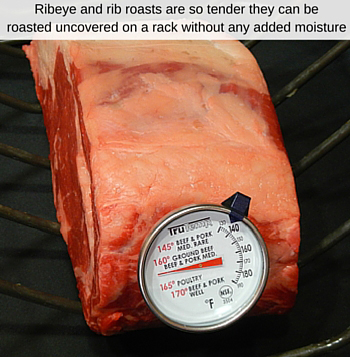 Rib and ribeye roasts are so tender they can be roasted in the oven to a desired temperature using a "dry heat" method. Many other types of roasts need "moist heat" to become tender. Rather than being cooked to "medium" or "medium rare," they're cooked until they are fork tender. Here are a few more facts about dry vs. moist heat.
Rib and ribeye roasts are so tender they can be roasted in the oven to a desired temperature using a "dry heat" method. Many other types of roasts need "moist heat" to become tender. Rather than being cooked to "medium" or "medium rare," they're cooked until they are fork tender. Here are a few more facts about dry vs. moist heat.
Dry heat roasting.Rib and ribeye roasts are roasted in the oven without any added liquid. Dry heat oven roasting works best with the most tender beef cuts, which include roasts cut from therib section and theloin section. This section is found along the backbone area of beef.
Moist heat roasting.Some other less expensive beef cuts can be oven roasted with dry heat if they're roasted at a slightly lower temperature for a longer time period. These include some cuts from the "round" section which is along the hind quarter. This heavily exercised section is less tender than the rib and loin sections. However, you may prefer the flavor of many cuts from the "round" section if you roast them by a "moist heat" method where they're browned and cooked — tightly covered — with added liquid in a heavy pot on top of the stove or in the oven. These types of roasts are often called "pot roasts. Here's how to pot roast several round section cuts and cuts from other sections that like moist heat to make they wonderfully tender.
Let's get started ... here are "3 Simple Steps for Oven Roasting Beef" from the Cattlemen's Beef Board and National Cattlemen's Beef Association (CBB/NCBA). NOTE: Click on the underlined words in red to access specific temperatures, times and further information. 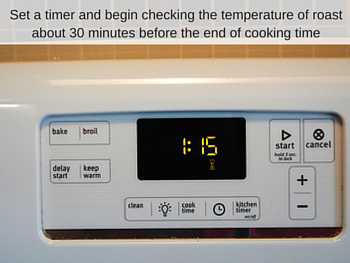 Important tip.
Important tip.
How to Prepare and Carve a Rib Roast
(Video information courtesy of The Beef Checkoff www.BeefItsWhatsForDinner.com)
Use the same steps for a ribeye roast, except place it on a rack in the roasting pan.
A sharp knife is important when carving a beef roast:
- Sharpen the knife in the same direction and slice on a cutting board in the same direction. Don't see-saw back and forth.
- Hold the knife at the same angle for each cut.
- Cut rib/ribeye roasts ½ to ¾ inch thick.
What you need to know about beef roast names
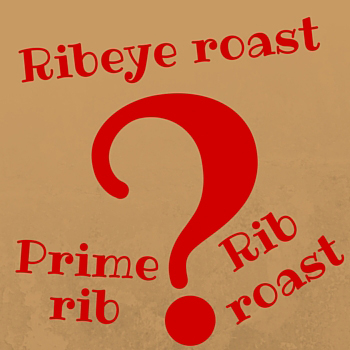 The terms used to describe roasts from the rib section of beef can be confusing. The three terms that cause the most confusion are "rib roast," "ribeye roast," and "prime rib." Here's what you need to know:
The terms used to describe roasts from the rib section of beef can be confusing. The three terms that cause the most confusion are "rib roast," "ribeye roast," and "prime rib." Here's what you need to know:
- A rib roast, like the name says, has the bones left in. It also is sometimes referred to as "Ribeye Roast Bone-In" or a "standing rib roast (which can include 2 to 7 rib bones)."The term "standing rib roast" is sometimes used because this roast is most often roasted "standing" on the rib bone rather than placed on a rack.
- A ribeye roast is a rib roast with the bones removed. Sometimes it is called a "boneless rib roast." You can purchase a "large end" or a "small end" ribeye roast. The small end cut is leaner and gives an impressive appearance on a holiday or special occasion table.
- A prime rib doesn't refer to a specific cut of beef. Rather, it is another name for sliced portions from a beef rib roast or ribeye roast after it is roasted. These roasts come from the rib primal section that consists of the 6th through 12th ribs.
TIP: It's better to ask the butcher for a "rib" or "ribeye" roast instead asking for a "prime" rib. "Prime" is a grade of beefproduced from young, well-fed beef cattle. It has abundant fat marbling and is generally sold in restaurants and hotels. It is the most expensive grade of beef and not needed for producing a delicious roast. The meat you normally buy at a grocery store is a "choice" grade and is quite tasty in a roast.
How much beef should you buy for a roast?
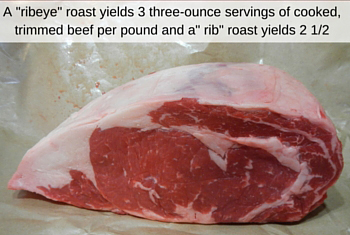 A recommended serving size of beef as part of a total meal pattern is 3 cooked ounces … about the size of a deck of cards. However, for special occasions and holiday events, you'll probably want to purchase more to provide a available amount equal to at least 5 to 6 cooked ounces per person. Here's the approximate number of 3 3-ounce cooked portions from rib and ribeye roasts given byCBB/NCBA:
A recommended serving size of beef as part of a total meal pattern is 3 cooked ounces … about the size of a deck of cards. However, for special occasions and holiday events, you'll probably want to purchase more to provide a available amount equal to at least 5 to 6 cooked ounces per person. Here's the approximate number of 3 3-ounce cooked portions from rib and ribeye roasts given byCBB/NCBA:
- Ribeye Roasts will yield 3 three-ounce servings of cooked, trimmed beef per pound. (For example, a 3-pound roast will yield 9 three-ounce cooked servings.)
- Bone-in Rib Roasts will yield 2-1/2 three-ounce servings of cooked, trimmed beef per pound. (For example, a 3-pound roast will yield 7-1/2 three-ounce cooked servings.
Buy roasts up to 3 to 4 days before cooking them.
Storing beef roast
 Store raw beef roasts unopened in the meat compartment or coldest part of the refrigerator at 40 degrees F or below and use within 3 to 4 days. Some packages of roasts will give specific"best if used by or freeze dates."
Store raw beef roasts unopened in the meat compartment or coldest part of the refrigerator at 40 degrees F or below and use within 3 to 4 days. Some packages of roasts will give specific"best if used by or freeze dates."
Freeze raw roasts in their retail packages for up to two weeks without a loss of quality. For longer storage, transfer them to plastic freezer bags, pressing out as much air as possible. Or rewrap them in heavy-duty aluminum foil. Label them with a description of the contents (type of beef cut, weight and/or number of servings) and the date. Freeze at 0 degrees F or colder. For best quality, use them within 6 to 12 months. However, when stored at 0 degrees F or lower, they will be safe indefinitely, though their quality may go down.
Thaw frozen beef roasts in your refrigerator in their wrapping and placed on a tray or other surface with edges to catch any drippings. Allow about 4 to 7 hours per pound for a large roast and 3 to 5 hours per pound for a small roast.
Refrigerate leftover cooked roast beef in shallow pans, loosely covered with foil, within 2 hours of serving. Transfer to covered containers after beef has cooled. Eat within 3 to 4 days or freeze in freezer bags with air pressed out or wrap in heavy-duty aluminum foil. Eat with 2 to 3 months for best quality; however, food will remain safe indefinitely if held in a freezer maintained at 0 degrees F.
Cooking equipment tips
Substitutes for a rack. 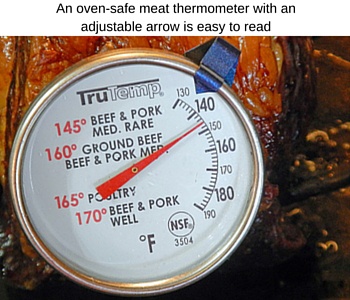 Substitutes for a roasting pan. If you don't have a roasting pan, here are some possible substitutes. The important point is the pan be shallow so your beef roasts rather than steams. Substitutes include: broiler pan, large cake pan, an oven-safe skillet.
Substitutes for a roasting pan. If you don't have a roasting pan, here are some possible substitutes. The important point is the pan be shallow so your beef roasts rather than steams. Substitutes include: broiler pan, large cake pan, an oven-safe skillet.
- Take a long sheet of aluminum foil and scrunch it into a thick rope shaped into a spiral. Place your roast on top.
- Use a wire rack used for baked goods if you have a large pan
- Use a wire rack that came with a toaster oven for a smaller pan.
Easy-to-read oven safe thermometer. An oven-safe meat thermometer with an adjustable arrow that can be adjusted to show the desired temperature at which to remove your roast from the oven is much easier to read. The temperature will rise 5 to 10 degrees during the 15 to 20 minutes standing time after removing the roast from the oven. Do NOT use an "instant read" thermometer which cannot be left in the oven.
Keeping your cutting board from slipping. If your cutting board keeps sliding around while you're trying to cut a roast, place a thin, wet cotton towel or paper towel under it to help hold it in place Get the towel wet and then squeeze out as much water as you can.
Planning the rest of your meal
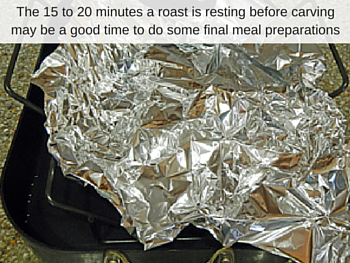 As it is impossible to tell the exact time your roast beef is done to perfection, you may find it easiest to plan foods that can be prepared and kept warm on low on top of the stove or that can be placed in the oven with the roast. Or choose foods that can be prepared or reheated during the 15 to 20 minutes that roast beef is standing after being roasted.
As it is impossible to tell the exact time your roast beef is done to perfection, you may find it easiest to plan foods that can be prepared and kept warm on low on top of the stove or that can be placed in the oven with the roast. Or choose foods that can be prepared or reheated during the 15 to 20 minutes that roast beef is standing after being roasted.
REMEMBER: Your roast is just LIGHTLY TENTED during this phase to retain heat.
Many times, friends and family like to help by bringing something to a meal. The best types of things to bring are foods that can be stored in the refrigerator and served cold or heated up in a microwave or the top of stove when the roast is ready to serve.
Recipes, rubs and lucious leftovers
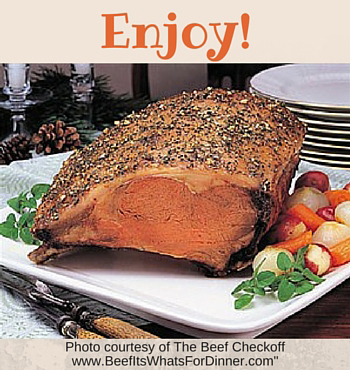 Recipes. For lots of recipe ideas, visit the CBB/NCBA website and search for ribeye or rib roast recipes at www.beefitswhatsfordinner.com
Recipes. For lots of recipe ideas, visit the CBB/NCBA website and search for ribeye or rib roast recipes at www.beefitswhatsfordinner.com
Rubs. A quick way to add flavor to a beef roast is a "rub" applied to the surface of the roast.
Luscious leftovers. Adding the leftover roast to recipes that contain liquid and where it can be cooked "low and slow" helps reheat it without drying it out. NOTE: If you roasted to a "medium rare" stage, it will no longer be at this degree of doneness but will still be delicious in its new transformation.
- Toss into soups and stews
- Use in shepherd's or pot pie
- Slice into thin strips, add BBQ sauce, heat and serve in buns
- Cut into chunks and use in a chili
- Make a French dip (roast is heated slightly in the au jus used with the French dip)
- Try cutting it into chunks and make a hash or a goulash
For a simple, tasty treat, serve a slice of cold roast with horseradish mayo on your favorite sandwich bread with lettuce and tomato.
Source: https://food.unl.edu/oven-roasting-guidelines-beef
0 Response to "What Temperature to Remove Beef From Oven"
Post a Comment